Introduction: Bridging Artistic Legacies
Willem Wissing stands as a significant figure in the narrative of late 17th-century portraiture, particularly within the vibrant artistic milieu of Restoration England. A Dutch painter by birth and training, Wissing successfully transplanted his skills to London, rapidly ascending to prominence following the death of the dominant court painter, Sir Peter Lely. Though his career was tragically cut short, Wissing enjoyed a period of considerable success, capturing the likenesses of royalty, aristocracy, and the influential figures of his time. His work provides a crucial link between the established style of Lely and the subsequent era dominated by Sir Godfrey Kneller, offering a distinct blend of Dutch realism and Baroque elegance. Often known correctly as Willem Wissing, his name has occasionally been anglicized or misspelled as William Wissing or even Wissmig in historical records, but scholarly consensus confirms the Dutch original.
Early Life and Artistic Formation in the Netherlands
Born around 1656, Willem Wissing's origins lie in the Netherlands, though sources sometimes differ between Amsterdam and The Hague as his precise birthplace. He came of age during the latter part of the Dutch Golden Age, a period renowned for its extraordinary artistic output, particularly in portraiture and genre painting. This environment undoubtedly shaped his early artistic sensibilities. His formal training took place in The Hague, a city with its own rich artistic traditions distinct from Amsterdam or Haarlem.
Wissing studied under notable masters in The Hague. His teachers included Willem Doudyns (1630–1697), a respected history and portrait painter who had travelled in Italy and absorbed classical influences. He also trained with Arnoldus van Ravesteyn (likely Arnold van Ravesteyn the Younger, 1615-1690), who belonged to a family of established portrait painters in the city. This training would have provided Wissing with a solid grounding in drawing, composition, and the techniques necessary for capturing a likeness, likely emphasizing the careful observation and detailed rendering characteristic of much Dutch art. Some accounts suggest a period spent studying in France, possibly Paris, before his move to England, though concrete evidence for this remains elusive. If true, it might have exposed him to the more formal French Baroque styles prevalent under Louis XIV.
Arrival in England and the Studio of Sir Peter Lely
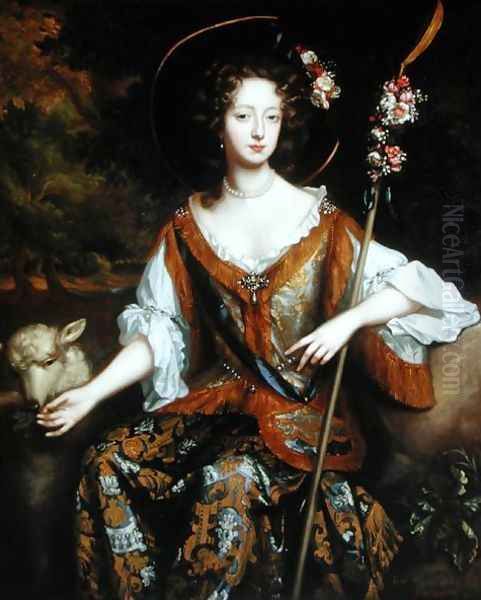
Around 1676, Wissing made the pivotal decision to move to England. London, particularly after the Restoration of the monarchy in 1660, had become a magnet for artists seeking patronage. The court of Charles II and the expanding aristocracy created a high demand for portraits, a demand previously met by the Flemish master Sir Anthony van Dyck and, in Wissing's time, dominated by Sir Peter Lely (1618–1680). Lely, originally from the Netherlands himself (born Pieter van der Faes), had become the undisputed leading portrait painter in England, appointed Principal Painter to the King.
Wissing entered Lely's highly successful and busy studio as an assistant. This was a common practice for aspiring artists, offering invaluable experience and exposure. Working under Lely, Wissing would have learned the master's methods, his characteristic poses, his rich palette, and his techniques for rendering luxurious fabrics and flattering complexions. Lely's style, heavily influenced by Van Dyck, defined court portraiture of the era, emphasizing elegance, languor, and aristocratic poise. Wissing proved to be a capable student and assistant, absorbing these elements effectively. He is often considered one of Lely's most important pupils.
Forging an Independent Career
The death of Sir Peter Lely in 1680 created a significant vacuum in the London art world. While Lely had dominated the scene for decades, his passing opened opportunities for other talented painters. Willem Wissing was perfectly positioned to capitalize on this. Having worked closely with Lely and demonstrated his skill, he was a natural successor for many of Lely's patrons. It is known that Wissing, along with perhaps other senior assistants, helped complete some of the portraits left unfinished in Lely's studio, further cementing his connection to Lely's clientele.
Wissing quickly established his own independent practice and rapidly gained favour. He possessed the technical skill and the fashionable style required to appeal to the court and the nobility. His Dutch training, combined with his experience in Lely's workshop, allowed him to produce portraits that were both well-executed and aligned with the prevailing tastes. He soon found himself competing for commissions with other portraitists active in London, most notably the German-born Godfrey Kneller, who had arrived in England a couple of years before Wissing, and the established English painter John Riley (1646–1691).
Artistic Style and Technique
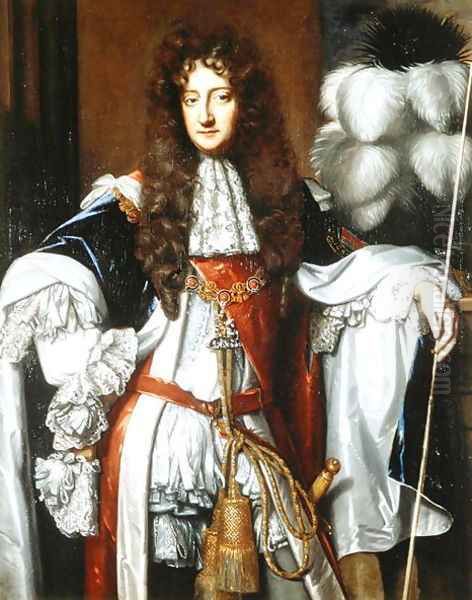
Willem Wissing's style is firmly rooted in the Baroque tradition, heavily shaped by his time with Lely. His portraits typically display the elegance, richness, and often the standardized poses favoured by his master and derived ultimately from Van Dyck. However, his work is not merely imitative. Some critics detect subtle differences, perhaps a slightly cooler palette at times, or a handling of flesh tones that retains a hint of his Dutch origins, possibly showing a greater interest in naturalistic observation than the sometimes idealized figures of Lely.
His technique was characterized by a smooth finish, careful blending of tones, and meticulous attention to detail, especially in the rendering of costumes. He excelled at depicting the textures of silks, satins, velvets, and lace, which were essential elements of aristocratic portraiture, conveying the sitter's wealth and status. Like Lely, he employed a range of poses, often three-quarter or full-length, set against landscape backgrounds or simple drapery. While some poses might appear conventional or repeated across different sitters – a common practice in busy studios catering to high demand – Wissing generally succeeded in creating likenesses that were considered both accurate and flattering. His ability to capture a sense of the sitter's presence and personality, within the formal constraints of the genre, was key to his success. His work can be seen as a continuation of the Lely tradition, perhaps lacking Lely's occasional psychological depth but consistently delivering polished and fashionable results. One might see echoes of refined Dutch painters like Gerard ter Borch or Caspar Netscher in his careful rendering, adapted to the grander English scale.
Royal and Aristocratic Patronage
A significant measure of Wissing's success was his impressive list of patrons, which included the highest echelons of English society and the Royal Family itself. He received commissions from King Charles II before the monarch's death in 1685. He also painted Charles's queen consort, Catherine of Braganza. The patronage continued under the next reign; Wissing painted James II (when Duke of York and later as King) and his second wife, Mary of Modena.
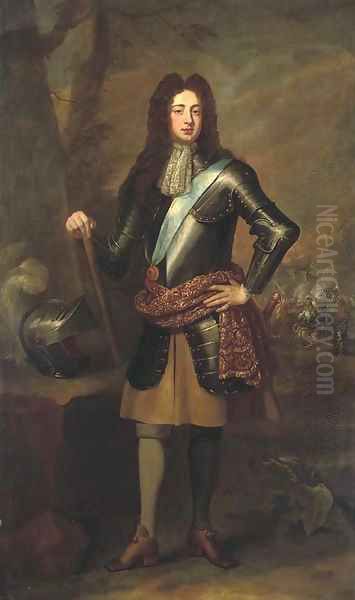
Other prominent royal sitters included Princess Anne (later Queen Anne) and her husband, Prince George of Denmark. One of his most famous, and perhaps politically charged, commissions was the portrait of James Scott, Duke of Monmouth, Charles II's illegitimate son who would later lead an ill-fated rebellion against James II. Painting such figures placed Wissing at the very centre of court life and political power. Beyond the immediate royal circle, he was sought after by numerous dukes, earls, countesses, and other members of the nobility, all eager to have their status recorded in the fashionable style he offered. These commissions ranged from grand, formal state portraits to more intimate depictions.
Notable Works
Several key works exemplify Willem Wissing's style and importance during his relatively brief career. His portrait of Elizabeth Jones, Countess of Kildare is often cited as a prime example of his elegant female portraiture, showcasing his skill in rendering fabrics and capturing a refined, aristocratic demeanor. The painting displays the characteristic Lely-esque pose and attention to fashionable detail that appealed to his clientele.
The portrait of Laurence Hyde, 1st Earl of Rochester, now in the Holburne Museum, Bath, demonstrates his ability to convey male authority and character. The depiction of Hyde, a prominent politician, focuses on his status, conveyed through rich attire and a confident pose, while also capturing a specific likeness. This work highlights Wissing's mastery of texture and the play of light on different materials.
His portrait of James Scott, Duke of Monmouth, painted around 1683-85, is significant both artistically and historically. It depicts the handsome and popular Duke near the height of his influence, before his tragic rebellion. The painting captures the charm and ambition attributed to Monmouth, rendered with Wissing's typical polish.
In 1685, Wissing travelled to the Netherlands specifically to paint portraits of Prince William III of Orange and his wife, Princess Mary (daughter of James II). These portraits were important commissions, given William and Mary's position and their eventual ascension to the English throne in 1689. The portrait of William III (versions exist, including one in private UK collection mentioned in sources) shows Wissing adapting his style to depict the future king, emphasizing his authority and resolve. Another noted work is the portrait of Anna Maria Talbot, Countess of Shrewsbury, known for her beauty and scandalous life, whom Wissing depicted with characteristic elegance.
Studio Practice and Collaboration
Like most successful portrait painters of the era, Willem Wissing operated a studio that likely employed assistants to help meet the demand for his work. This was standard practice, inherited from masters like Van Dyck and Lely, and continued by contemporaries like Kneller. The principal artist would typically focus on the face and perhaps the hands, while assistants, often specialists, would paint the drapery, backgrounds, and sometimes replicate versions of successful portraits.
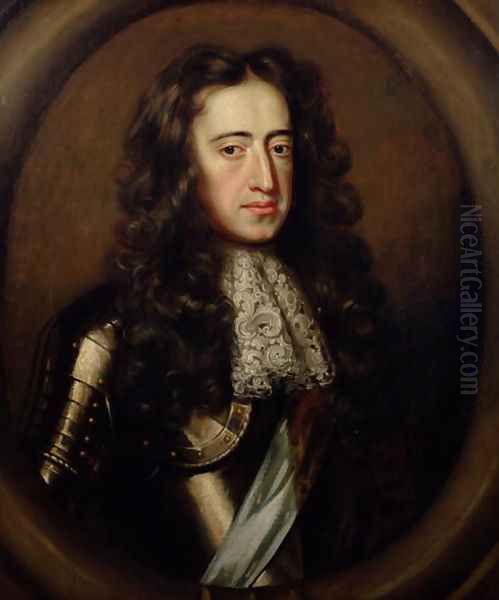
The most well-documented collaborator in Wissing's studio was another Dutch immigrant artist, Jan van der Vaart (c. 1650–1727). Van der Vaart was known for his skill in painting drapery and landscape backgrounds, and he worked closely with Wissing, adding these elements to many of his portraits. This collaboration allowed Wissing to maintain a high output without compromising the quality expected by his patrons. Van der Vaart continued to work independently and as a drapery painter for others after Wissing's death.
There is also speculation, supported by research like that of Diana Dethoff, that Wissing may have occasionally collaborated with specialist flower painters, such as Simon Verelst (1644–1721), another Dutch artist active in London known for his exquisite floral details. While Verelst also painted portraits, collaborations where specialists added specific elements like flowers to portraits were not uncommon, reflecting the patrons' desire for intricate detail and symbolic content. Such studio practices were essential for the business side of art in the 17th century. Other contemporaries like the Swedish-born Michael Dahl (c. 1659–1743), who arrived in London later, also operated with studio assistance.
Rivalry with Godfrey Kneller
Following Lely's death, the main competition for dominance in the London portrait market was between Willem Wissing and Godfrey Kneller (1646–1723). Kneller, born Gottfried Kniller in Germany, had studied in the Netherlands and Italy before arriving in England around 1676, roughly the same time as Wissing. Both artists were highly skilled, trained in continental traditions, and adept at producing the kind of grand, flattering portraits desired by the English elite.
For several years in the early 1680s, Wissing and Kneller were direct rivals, vying for the most prestigious commissions. Wissing initially seemed to have a strong connection to the court of James II. Both artists were prolific and successful during this period. However, Kneller possessed advantages that would ultimately secure his long-term dominance: he was slightly older and perhaps more established internationally before arriving, he was exceptionally adept at self-promotion and managing a large-scale studio operation, and, crucially, he lived much longer. Wissing's early death removed Kneller's most significant competitor. Kneller would go on to dominate English portraiture for the next three decades, painting monarchs from Charles II to George I and establishing a style that defined the Augustan age. While Wissing was a serious contender, his brief career meant he couldn't build the enduring influence Kneller achieved. Other painters like John Riley and Jacob Huysmans (c. 1633–1696), a Flemish painter popular earlier in Charles II's reign, were also part of the competitive landscape, but the primary contest after 1680 was between Wissing and Kneller.
Later Years and Untimely Death
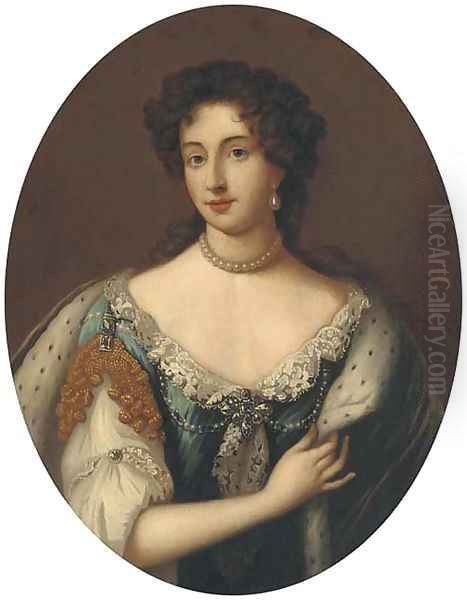
The mid-1680s represented the peak of Willem Wissing's career. He was in high demand, enjoying royal favour and numerous commissions from the aristocracy. His trip to the Netherlands in 1685 to paint William and Mary further enhanced his reputation. He seemed poised for a long and successful career at the forefront of English portraiture.
However, his flourishing career came to an abrupt end. In September 1687, while working on commissions for the Earl of Exeter at Burghley House near Stamford, Lincolnshire, Willem Wissing fell ill and died. He was only about 31 years old. His death was sudden and unexpected, cutting short a career that had shown immense promise. He was buried at St Martin's Church in Stamford.
Controversies and Unanswered Questions
Despite his prominence, certain aspects of Wissing's life and work remain subjects of discussion or speculation among art historians. As mentioned, the details of his early life, particularly the possibility of study in France, are not definitively confirmed by primary sources.
The precise nature and intensity of his rivalry with Godfrey Kneller are also debated. While clearly competitors, the extent to which personal animosity existed, beyond professional competition, is unclear. Some contemporary accounts might be coloured by partisanship.
Artistically, while his skill is acknowledged, some critics have pointed to a certain formulaic quality in some of his works, particularly the repetition of poses for different sitters. This was, however, a common feature of Baroque studio production rather than a unique failing of Wissing. Questions of attribution occasionally arise, distinguishing his hand from that of his assistants or differentiating his later work from early Kneller can sometimes be challenging.
The fate of works potentially left unfinished at his death is another area of uncertainty. For instance, sources mention an unfinished portrait of Mary of Modena, the whereabouts of which are unknown, leaving gaps in our understanding of his final projects.
Perhaps the most persistent, though unsubstantiated, mystery surrounding Wissing is the rumour that circulated after his death suggesting he might have been poisoned, possibly out of professional jealousy. There is no solid evidence to support this claim, and it likely falls into the realm of historical gossip, but it adds a layer of intrigue to his biography. His death was officially attributed to smallpox by some sources, a common and deadly disease at the time.
Legacy and Influence
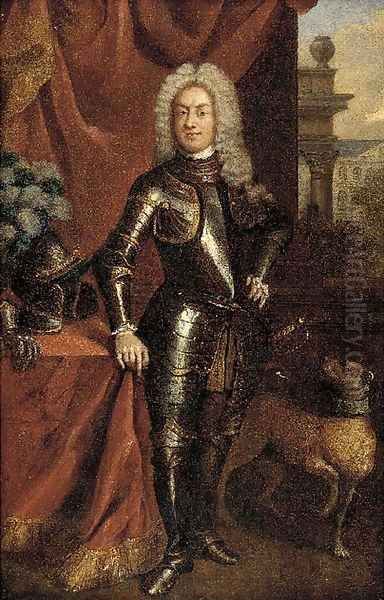
Willem Wissing's legacy lies primarily in his role as a key portrait painter in England during the crucial decade of the 1680s. He successfully bridged the gap between the dominance of Sir Peter Lely and the long reign of Sir Godfrey Kneller. For a period, he was arguably the most fashionable painter at the court of James II. His works provide invaluable visual records of the leading figures of Restoration society, capturing their appearance, status, and the style of the era with considerable skill and elegance.
His influence can be seen in the continuation of the Anglo-Dutch portrait tradition established by Van Dyck and Lely. He helped perpetuate this style, characterized by its blend of formality, richness, and flattering presentation. While his early death prevented him from developing his style further or establishing a large school of followers in the way Kneller did, his work was certainly known and respected by his contemporaries. His collaborator, Jan van der Vaart, continued to work in London for many years, carrying forward elements of the studio's practice.
Wissing's portraits were also disseminated through engravings, notably by artists like John Smith (c. 1652–1743), which helped to spread his imagery and reputation both during his lifetime and after his death. Today, his paintings are held in numerous important collections, including the Royal Collection, the National Portrait Gallery in London, the Scottish National Portrait Gallery, Tate Britain, the Metropolitan Museum of Art in New York, and various historic houses and regional museums across the UK and internationally. While perhaps overshadowed in the grand narrative of art history by longer-lived figures like Lely, Kneller, or the towering masters of the Dutch Golden Age like Rembrandt and Frans Hals, Wissing remains a significant artist whose polished and perceptive portraits capture the essence of a specific moment in English history and art.
Conclusion
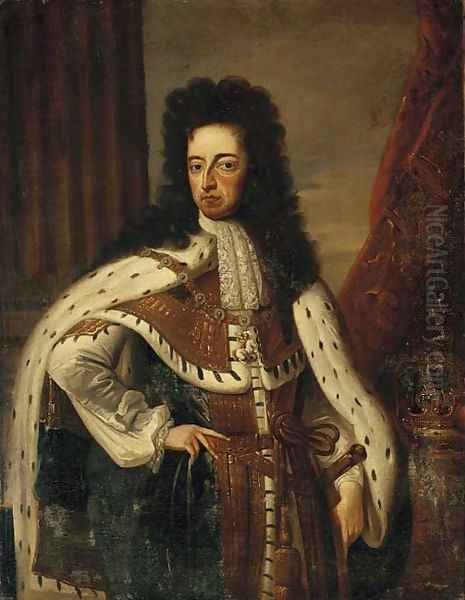
Willem Wissing's career, though brief, was impactful. Arriving in England as a talented young Dutchman, he quickly absorbed the prevailing style of Sir Peter Lely and emerged as a leading portraitist in his own right following his master's death. For nearly a decade, he catered to the highest levels of English society, producing elegant and technically accomplished portraits of royalty and nobility. His work exemplifies the Baroque aesthetic favoured by the Restoration court, blending Dutch attention to detail with the grand manner inherited from Van Dyck and Lely. While his untimely death in 1687 cleared the path for the long dominance of Sir Godfrey Kneller, Wissing left behind a significant body of work that remains crucial for understanding the art, personalities, and politics of late 17th-century England. He stands as a testament to the fruitful cross-cultural exchanges that enriched European art during this period.